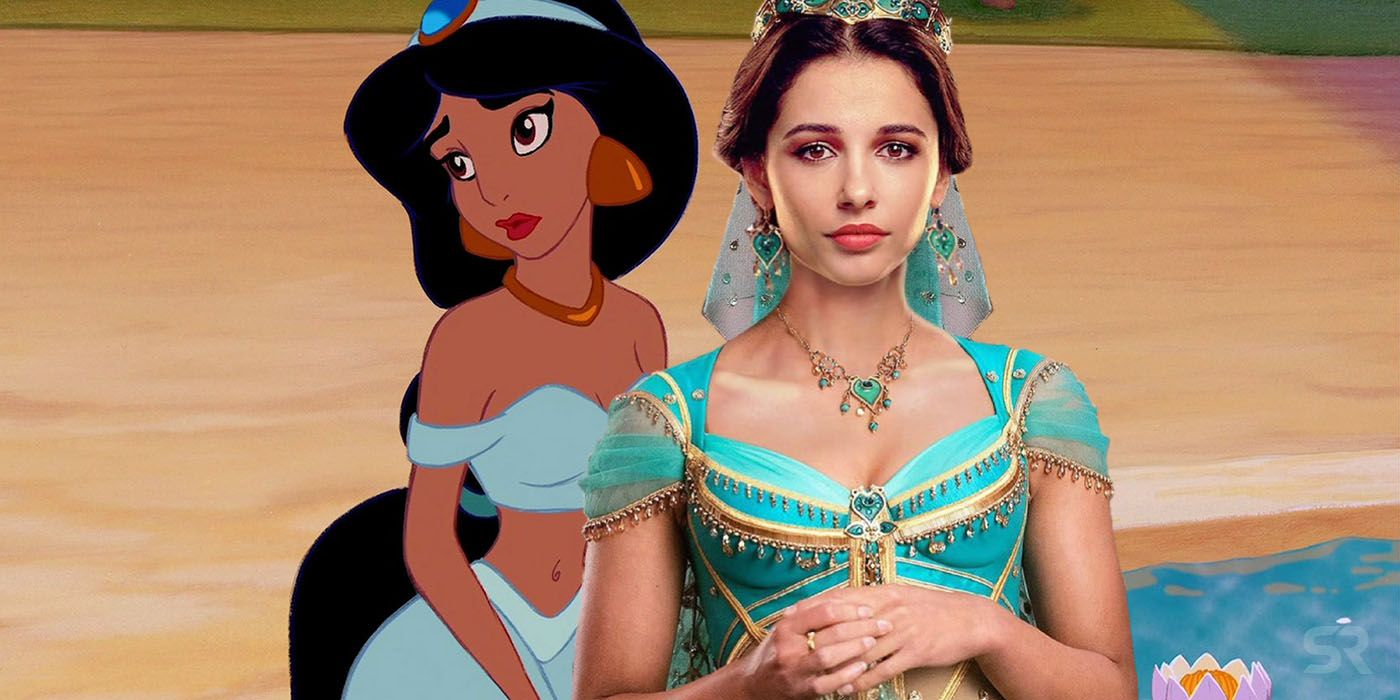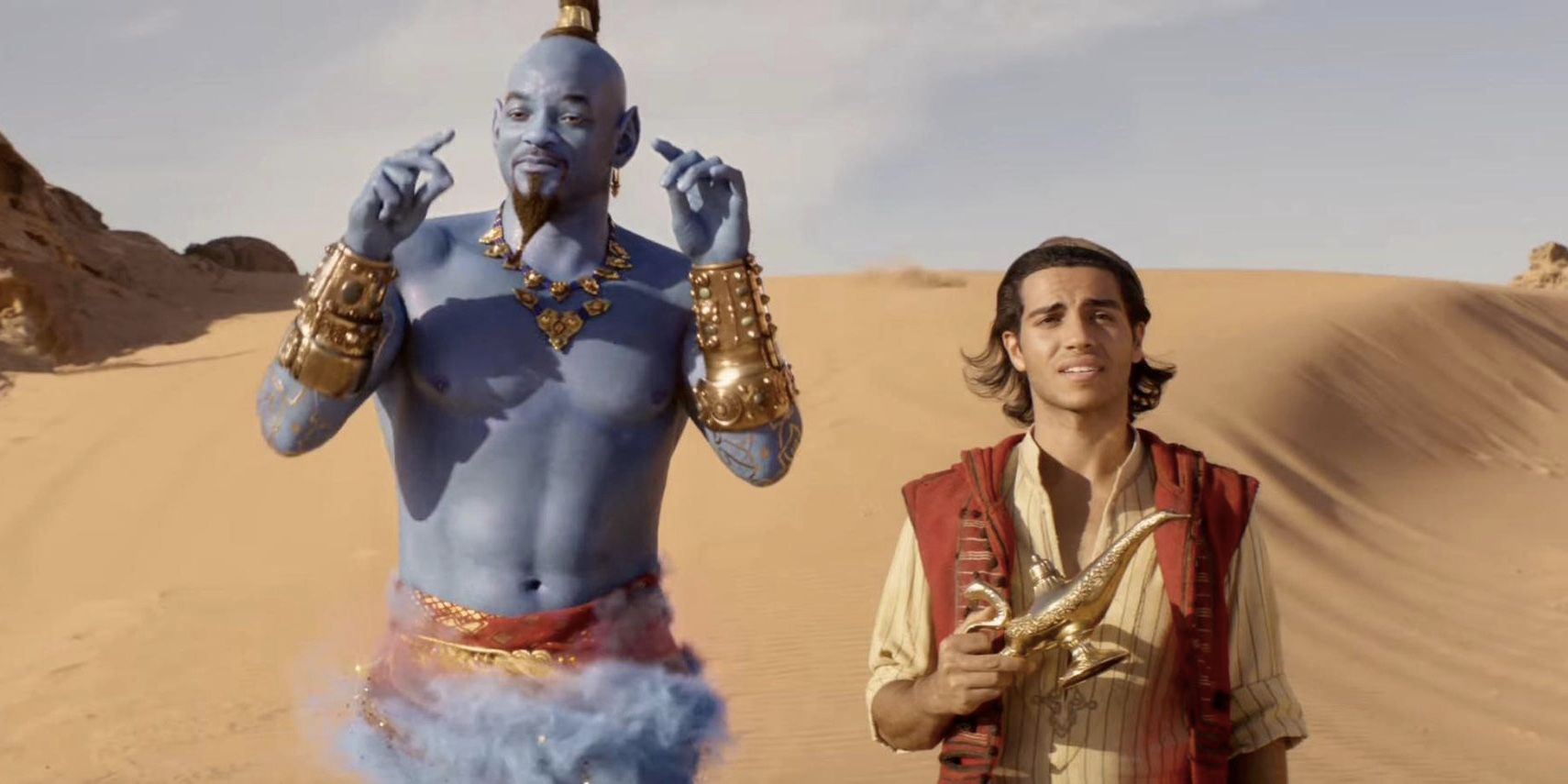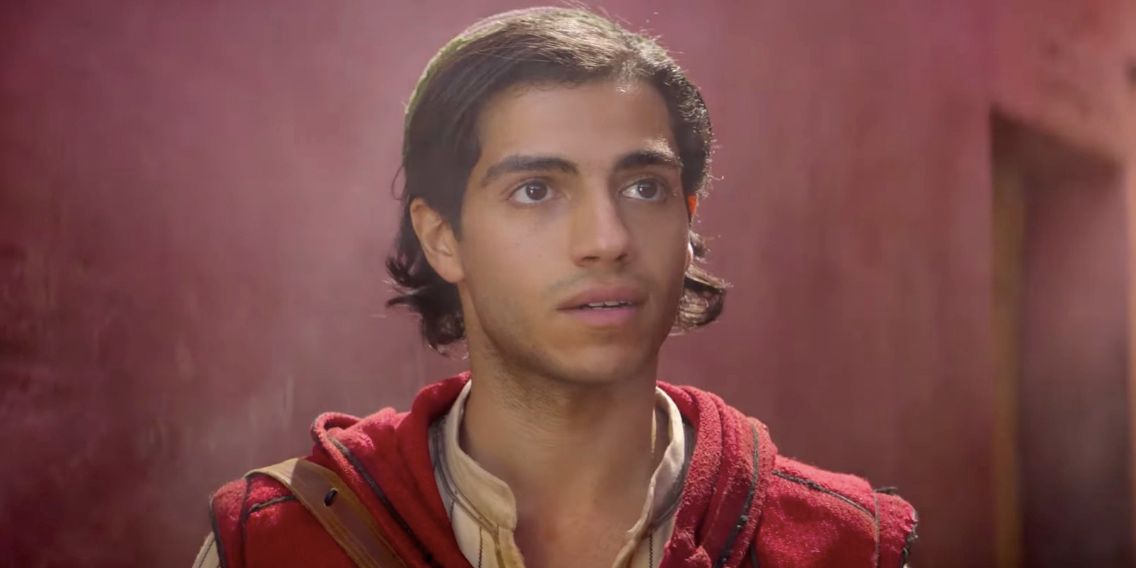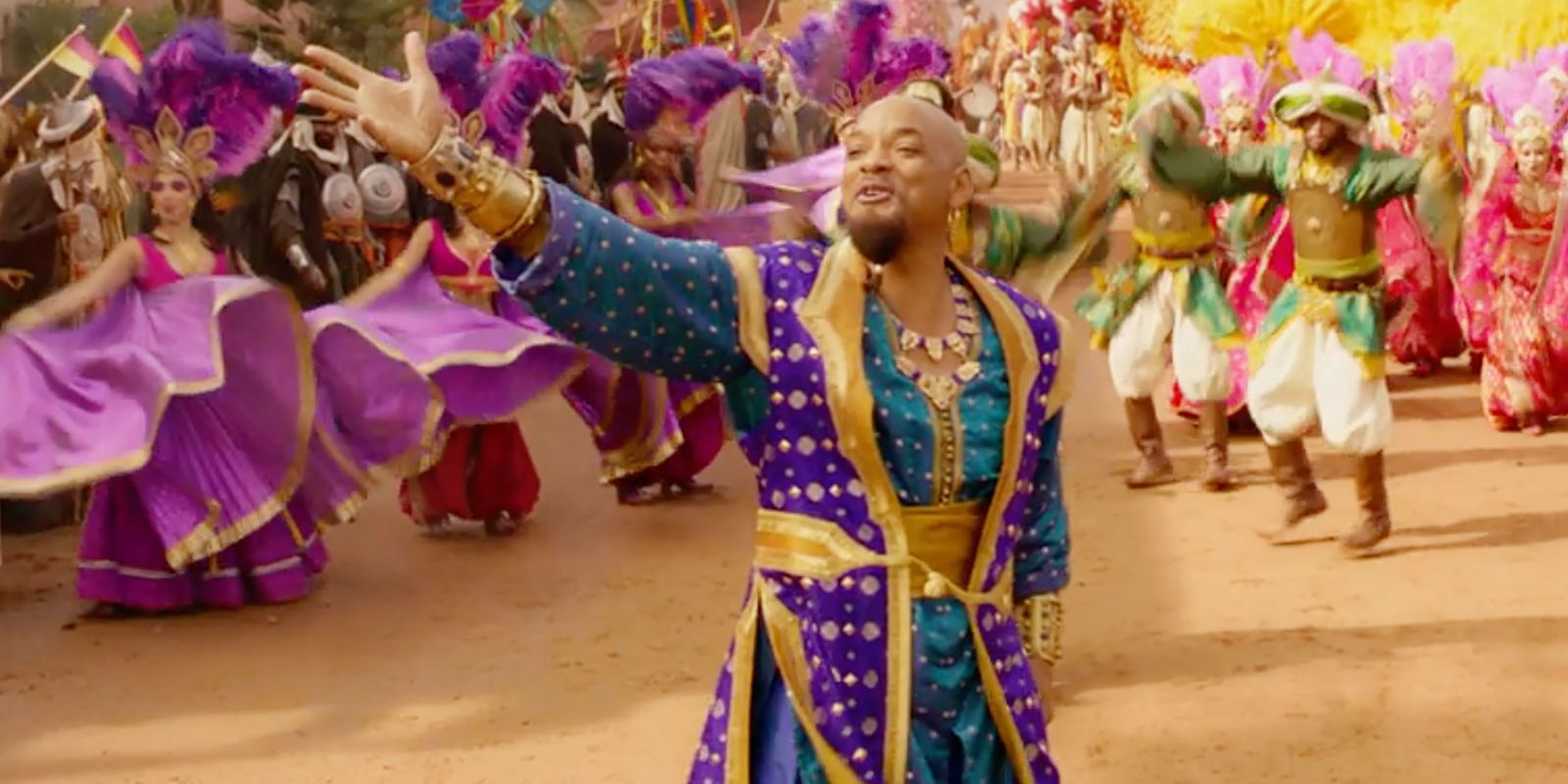The latest Disney live-action remake works to fix issues with the source material, but in the case of Aladdin, many of the choices make a lot of sense. With the release of Aladdin this week, The Walt Disney Company is two thirds of the way through its 2019 slate of live-action remakes. The photo-realistic take on The Lion King opens this summer and is expected to perform strongly, but Tim Burton’s Dumbo disappointed with audiences and critics alike.
Aladdin, of the three, was the one written off heavily by industry experts as a flop in waiting, in large part thanks to uninspiring trailers, a questionable director choice, and basically everything surrounding the blue CGI Genie that is Will Smith. In terms of taking genuine risks (something Disney is notoriously averse to) Aladdin felt like the biggest leap for the studio in terms of these remakes. The entire point of them has been to make the safest box office bets possible, and as evidenced by the combined multi-billion dollar grosses for titles like The Jungle Book and Beauty and the Beast, it’s paid off marvelously.
Disney has been heavily criticized for the inherently limiting nature of these live-action remakes. They primarily serve two functions beyond mere profit: to strengthen the brand and public awareness of the original properties, and to fix mistakes or elements that have not aged well over the passing years. The former explains why these remakes often adhere so faithfully to the source material, often shot-for-shot, but the latter is where things get interesting.
Disney Live Action Remakes Keep Trying to “Fix” Problems From the Original Movies
Attempts to "fix" classic stories have been executed to mixed effect with Disney’s live-action remakes. Cinderella fleshed out the backstory and motivations of the evil stepmother, but weakened the overall menace of her character. Maleficent re-imagined Sleeping Beauty from the villain’s point-of-view and gave her a surprisingly dark origin story that put the audience on her side. The Jungle Book gave Shere Khan a proper reason to hate Mowgli’s presence in the jungle - one with tangible consequences. Dumbo’s added subplot about corporate takeovers and the fear of selling out proved to be one of the more baffling creative choices made in a major blockbuster this year so far.
Perhaps the clumsiest version of this can be seen in 2017’s Beauty and the Beast. Arguably the most beloved film of the Disney Renaissance, the remake shows how Disney was keen to not deviate too far from what made the original so special, but also address the nitpicks and dynamics that have inspired many an argument over the preceding years. Belle was given a supposedly feminist motivation as an inventor that went nowhere, Gaston was given a traumatic backstory as a war veteran that neutered the elements that made him so insidious in the first place, and plot holes from the original were “fixed” in ways that just led to more unanswered questions. It highlighted how narrow a path Disney must navigate with these remakes: How do you justify their existences but still ensure they fulfill their duties as branding exercises?
Aladdin in many ways is the ideal film for this treatment, but also the one fraught with the most possibilities for failure. The original movie was highly controversial in its time for its problematic portrayal of Middle-Eastern culture, as depicted by white film-makers. To this day, Aladdin is still used in academic circles as an example of Hollywood’s Orientalism. As enjoyable as Aladdin is and as entertaining as it remains to this day, it’s undeniably a story about a vaguely defined Middle-Eastern world, as told by white people and intended for a primarily white audience. For a studio hoping to offer an update to such a story that fixes said issues and helps the film appeal to a greater international audience, there is certainly room to grow (although the film still has an all-white team of writers and director, which raised more than a few eyebrows). For Aladdin, the “fixes” made by Disney are both subtle and more blatant.
The Aladdin Remake Tries to Fix the Racial Problems
Aladdin may have been a big step forward in terms of Disney animation’s racial diversity but that never excused the severe problems with the movie’s portrayal of Arab culture. One of the verses of the opening song "Arabian Nights" was altered following complaints from the American-Arab Anti-Discrimination Committee. The lyrics were changed in July 1993 from "Where they cut off your ear if they don't like your face," in the original release to "Where it's flat and immense and the heat is intense" with the home video release. In the new film, the lyric is changed even further to replace “barbaric” with “chaotic”.
Other moments that were criticized in the original film for portraying the Arab world in the movie as violent and cruel have been changed. For example, when Jasmine takes some food to give to some hungry children, the merchant demands her bracelet as payment rather than her hand. A rather awkward lyric in "Prince Ali" that boasts, "he's got slaves, he's got servants and flunkies" has been changed to "he's got ten thousand servants and flunkies," since being a slave owner isn't really a desirable quality in a Disney hero. And a line from the same song where Genie instructs the crowds to "brush up your Sunday salaam" has been corrected to "brush up your Friday salaam," since Friday is the Muslim holy day.
In terms of the depictions of heroes and villains in this film, the Aladdin remake goes a long way by actually having people of colour in its cast rather than being animation created by a primarily white team. As Roger Ebert noted in his review of the original film, "Most of the Arab characters have exaggerated facial characteristics – hooked noses, glowering brows, thick lips – but Aladdin and the princess look like white American teenagers." Mena Massoud and Naomi Scott play the two leads, but the most noticeable change comes with Marwan Kenzari. The new Jafar is younger and not racially coded in the same way as the original cartoon. There's a deeper significance to all those “hot Jafar” memes; having the villain be just as handsome, if not more so, than the hero is indeed its own form of progress.
One major way the film deals with the exoticizing of its characters is through the treatment of Jasmine. The princess was criticized upon the first film’s release for her over-sexualized design, including a moment where she seduces Jafar after he makes her his slave. In the remake, she is given more agency overall, but especially in the confrontation with Jafar. He does not lust after her or leer over her body, nor is she forced into a revealing outfit. When Jafar forces her to marry him, it’s not about sex but power. He is a clear misogynist who tells her on multiple occasions that her job is to be seen and not heard, and he sees marriage as a way to control her. It’s a subtle twist but one that makes all the difference. This downplaying of the original’s sexualized content also includes turning the harem girls seen in the "One Jump Ahead" and "Prince Ali" numbers to schoolgirls.
Related: Every Song In The Aladdin Remake
This is not to say that the Aladdin remake – which is still written and directed by white men – has fixed all of these problems or dealt with the Orientalism that Hollywood still favors to this day. The Council on American-Islamic Relations said that the Aladdin story "has always been associated with depicting Arabs and Muslims as barbaric, uncivilized ‘others,’ following a long pattern of anti-Muslim attitudes in Hollywood. The release of Aladdin coincides with ongoing Islamophobic content in mainstream entertainment media." It is important to center these concerns and voices during discussions of films like this, especially since Aladdin is a high-profile Hollywood movie with Arab and Middle Eastern characters and culture at its heart, and therefore will have a significant impact on how audiences (and especially children) view that culture.
Plot Holes Are Dealt With and Small Changes Made
Often when Disney tries to fix so-called plot holes with live-action remakes, it merely creates new problems or adds unnecessary complications that do not improve the story or characterization fans loved so much in the first place. Beauty and the Beast suffered greatly from this, filling in details on Belle’s mother, the Beast’s childhood, and details of the curse that felt unnecessary and uninteresting (such details also help to pad out these remakes to a running time longer than the original movies).
Aladdin is somewhat savvier on this front. Less pressing questions are quickly answered then the narrative is allowed to move on, meaning the movie isn’t bogged down with trying to fix things that were never broken in the first place. Aladdin's parentage and Jasmine's late mother are confirmed but not turned into a strange subplot like Belle's mother in Beauty and the Beast. Everyone also catches on very quickly that Ababwa (a place name made up on the spot by a mumbling Genie), Prince Ali’s supposed home nation, does not exist - forcing a little magical intervention to keep up the ruse.
Other small changes are made to the narrative that keep the overall structure familiar to fans of the original but give a fresh spin to everything. For example, Aladdin sneaks into the Palace to see Jasmine, which is how Jafar discovers his diamond in the rough. When Jafar tries to kill Aladdin by throwing him out a window to drown, it now doubles as a witch test. The rules of the Genie's wishes are made a tad more complicated by the need for the person to be rubbing the lamp as they make their wish, which allows Aladdin to get his first wish free on a technicality.
RELATED: Aladdin Controversy Explained: Why The Disney Remake Has Divided Fans
Backstory Is Added and Characters Given Deeper Motivations
Jasmine is still troubled by the law's insistence that she marry a prince, but her emotional arc is given a stronger motivation than a mere desire for true love and freedom beyond the palace. Her ultimate dream is to be the Sultan herself and be a kind leader for the people of Agrabah, but the law dictates that a woman cannot rule, so she must marry and let her husband do that instead. It’s another subtle change, but one that makes a real difference.
Jafar is also given more motivation beyond lust for power. He is a former thief, a detail he shares with Aladdin when he convinces him to enter the Cave of Wonders. He tells Aladdin that the most important thing in the world is to not only be powerful but the mightiest person in the room, or you’re nothing. His insecurities over always being second to the Sultan have driven him to accumulate more power through any means necessary, and thus leads to his downfall.
The Genie also gets a love interest in the form of Jasmine’s handmaiden Dalia, played by Saturday Night Live alum Nasim Pedrad. This ties the story together as we see the Genie at the beginning of the film not as a merchant in disguise but as his now human self with a wife and children, telling them the tale of Aladdin.
Aladdin is a beloved movie for an entire generation of Disney fans, but it’s one that has always been fraught with issues over its racial insensitivity and the permanence of the white gaze on a story of Arab culture. Because of the original movie’s enduring popularity and its presence as a brand for the studio, it was inevitable that it would be remade, but Disney always had a mountain to climb with updating this story in ways that it needed to be. Given the immense constraints and corporate demands put upon these remakes, this is probably as good as any Aladdin remake was going to get in terms of dealing with those core problems. However, there is still a long way to go in terms of a major studio offering real diversity in terms of depictions of Arab and Middle Eastern culture, as well as offering the opportunities for marginalized voices to tell those stories themselves.





